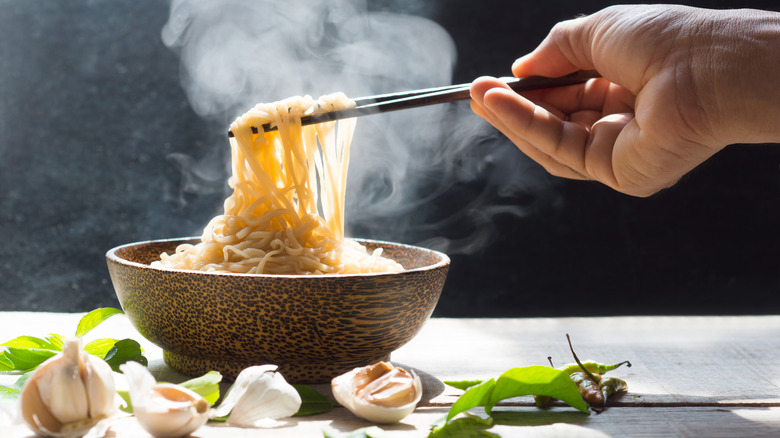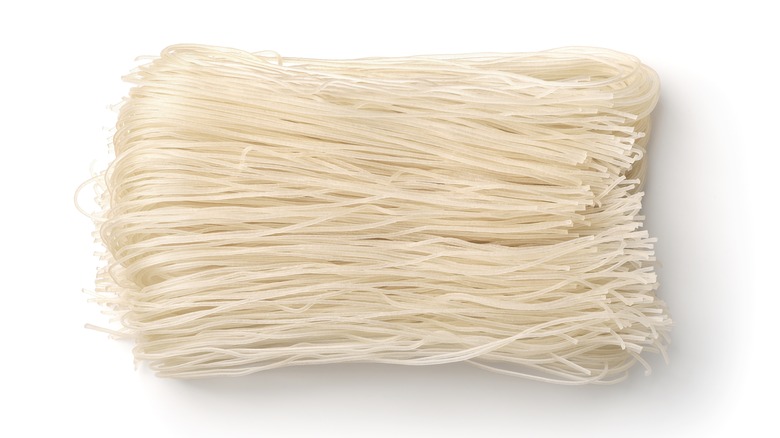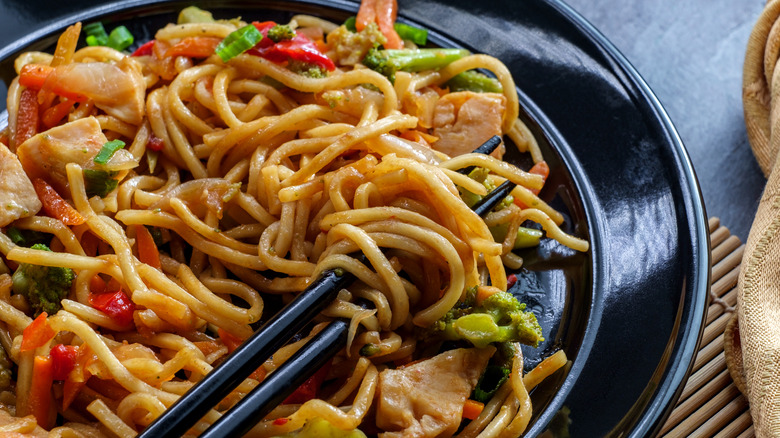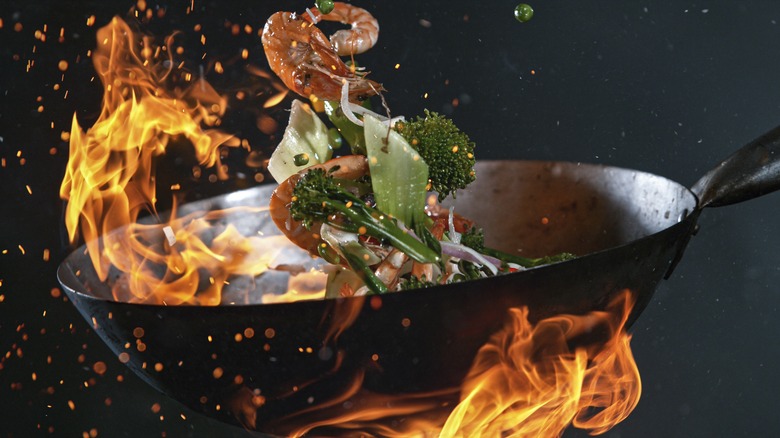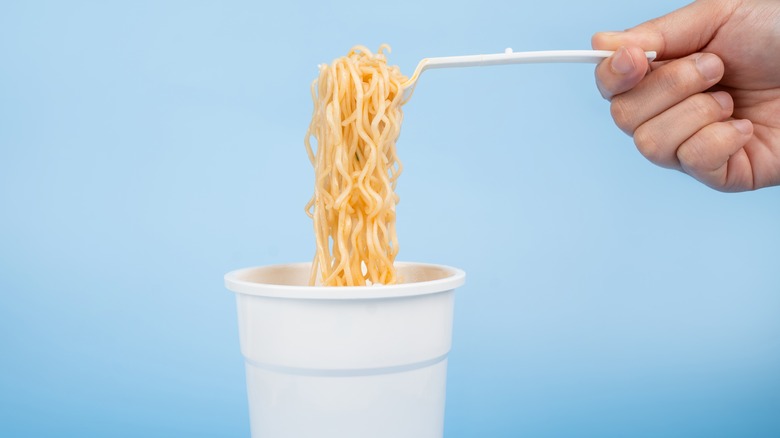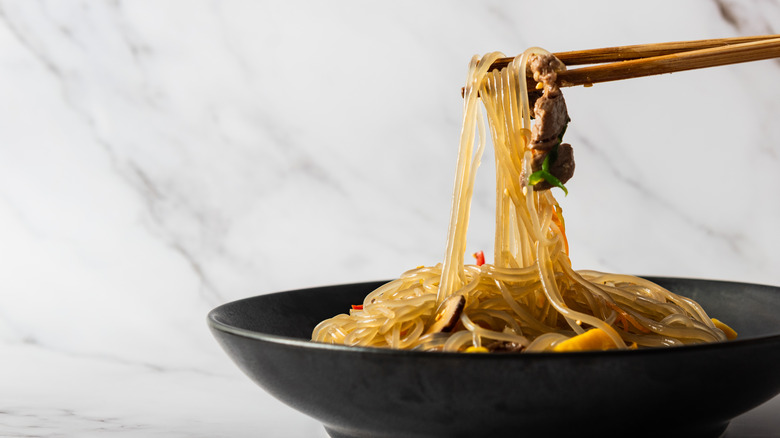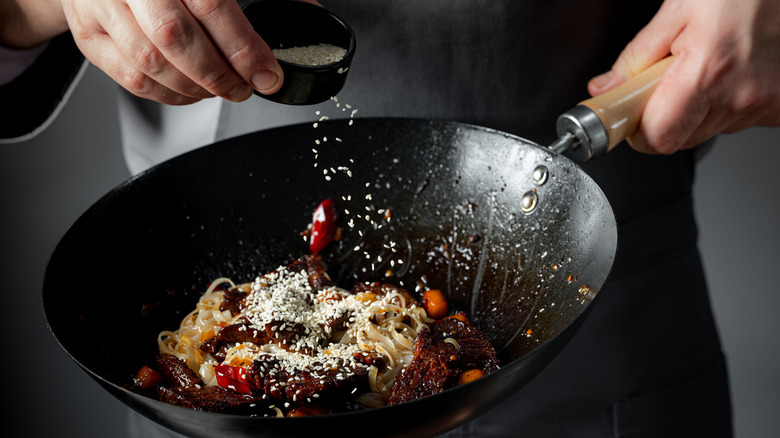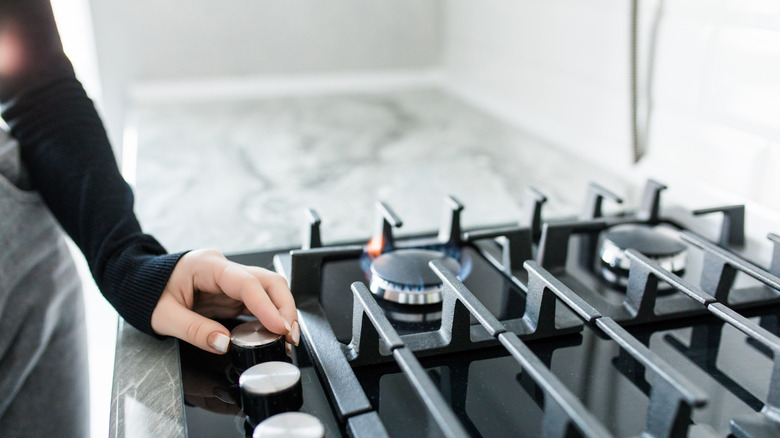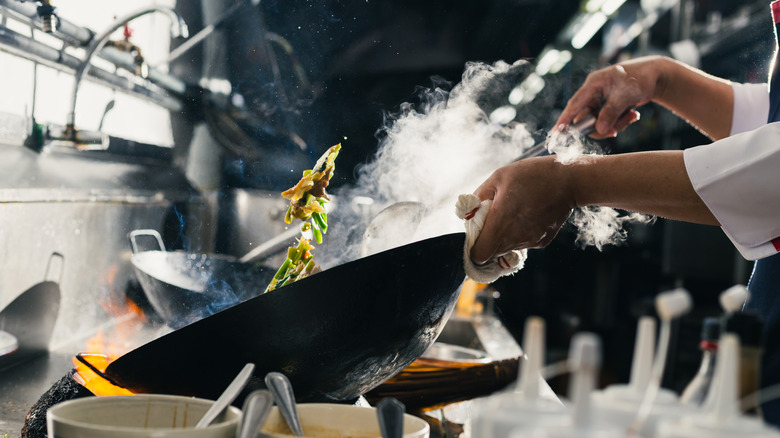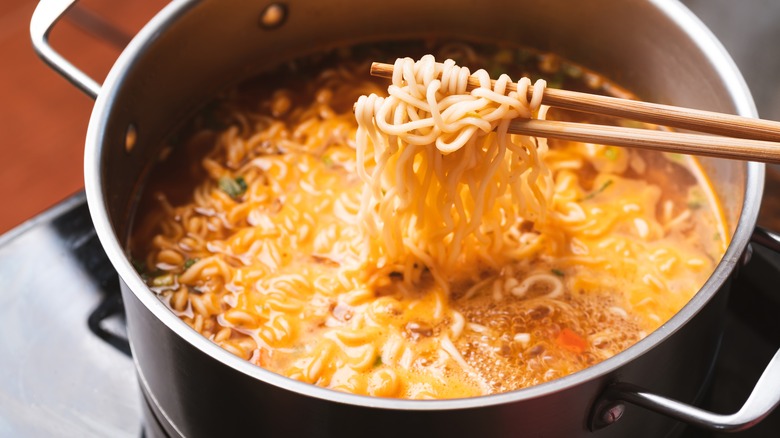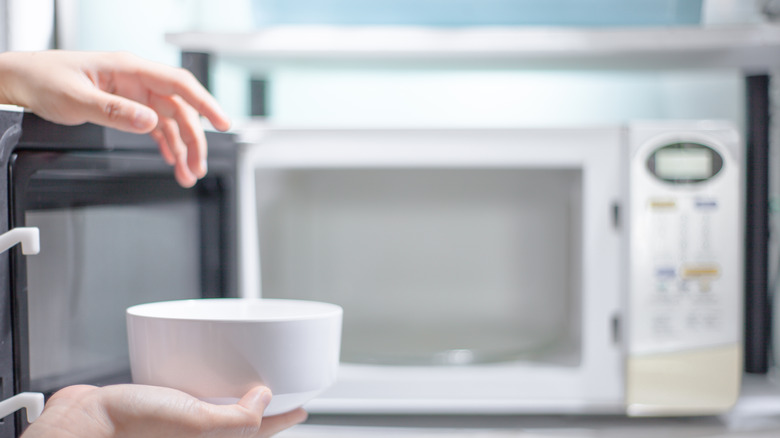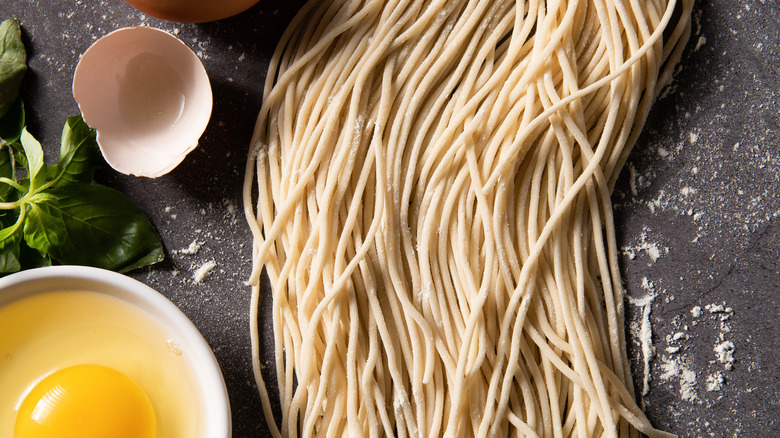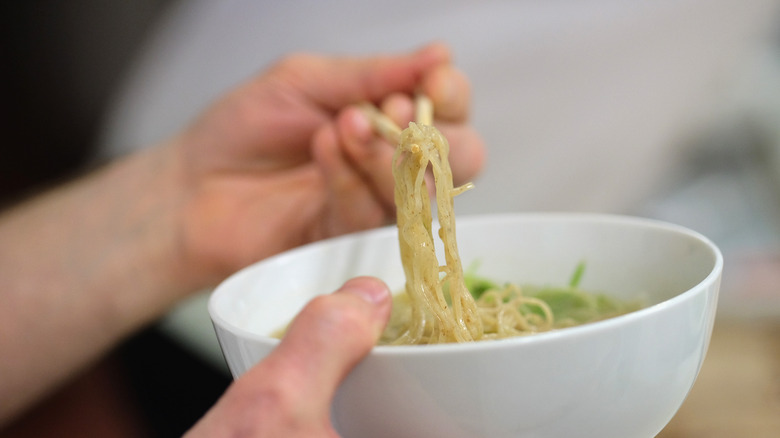Tips You Need When Cooking With Noodles
Noodles are a simple yet versatile ingredient in many cuisines. Although many people group noodles in with pasta, an Italian staple made with durum wheat, noodles are actually a separate category of starch. Noodles can be made of a broader range of ingredients than pasta, including rice (vermicelli noodles), mung beans (glass noodles), buckwheat (soba noodles), or wheat flour (ramen noodles). There is also a subtle difference in the mode by which the food is produced; noodle dough is usually passed through rollers and cut, while pasta dough is formed via molds. When it comes to serving, it is important to note that pasta is usually tossed in a sauce, while noodles can be added to a broth or stir-fried with proteins and vegetables.
Since there are so many differences between pasta and noodles, it is reasonable to assume that the best way to cook noodles may not be the same as pasta. Here are some of the most important things you need to know about cooking noodles at home.
Avoid clumpy rice noodles by rinsing after cooking
One of the most common mistakes everyone makes with spaghetti pasta is rinsing it with water to remove the starch. But can the same be said for rice noodles?
The short answer is yes. To keep rice noodles from sticking together, you'll want to either immediately incorporate the noodles into a sauce or stir fry to offset the sticky rice starches with an oily sauce. If you plan on saving the noodles for another part of the dish, first rinse the noodles with cold water to remove some of the rice starches, and then coat them with your favorite kind of oil. Rice noodles, and most Asian dishes, tend to lend well to peanut oil or sesame oil, but a douse-and-toss with a bit of canola oil does the trick too.
When cooking with rice noodles, it's important to follow the package directions for cooking and cooling. Nobody wants a tangled mess of rice noodles in a soup anyway!
Read the package directions to decide how much water to cook the noodles in
Not all noodles are made of the same ingredients, so not every noodle can be cooked the same way. The package of noodles is your go-to way to determine how best to cook the noodles as well as how much water to use.
The amount of water you use is also dependent on the style of noodles you're craving. One of the most common mistakes everyone makes with chow mein is not using the correct amount of water for wet chow mein (boiled noodles) versus dry chow mein (stir-fried noodles). If you plan on making dry chow mein, you'll want to decrease the amount of water used in the recipe to keep the noodles crisp and crunchy. If you want wet chow mein, boil the noodles in more water to prevent the starches from sticking together, and cook until the noodles are tender.
Use a wok for stir frying noodles
A wok is one of the most pivotal kitchen essentials for mastering Chinese cooking. We recommend using a hammered carbon steel wok for its durability as well as its high, even conductivity. For an electric stove, look for a flat-bottomed wok.
When cooking with a wok, it's important to avoid overcrowding it. Cooking in batches is always a wise idea, especially when you can cook vegetables, which usually need a little more time under the heat, separately from delicate noodles. Moreover, the purpose of cooking noodles in the wok is just to finish and season the noodles — not to re-cook them. If you plan on boiling noodles before adding them to the wok, be sure to avoid cooking the noodles past the point of no return. Once the noodles are in the wok, you'll want to master the art of tossing the wok to raise and flip the noodles in the sauce. We also recommend purchasing a wok spatula to help in the tossing process.
A secret ingredient for instant ramen may be lurking in your butter drawer
You probably don't associate butter with noodles outside of pasta, but this secret ingredient is a great way to ensure your instant ramen is a step above the rest. Consider adding a slab of butter to your ramen broth to maximize other spices and flavors in the seasoning. You'll instantly find that the butter contrasts the freshness of any veggies or proteins you add to your ramen. Plus, certain flavors of ramen can be spicier than others, so adding butter also helps balance out the capsaicin in the seasoning stemming from peppers and chili.
Besides amplifying existing flavors, butter also introduces a sweet undertone to your ramen. If you are short on butter, you can also use clarified butter (ghee) in your ramen broth. Plus, there isn't much that's more satisfying than watching a slab of butter or ghee melt into the noodles on your plate.
Match the noodles to the sauce
Adding macaroni to a meat sauce is sinful, so why would we expect anything less from mixing the wrong type of noodle with the wrong type of sauce? Just like its pasta cousin, different kinds of noodles are suited to different kinds of sauces and preparation methods. While glass noodles are typically found in hot pots and soups, rice noodles are much more hearty and can withstand the heat of stir fry and drunken noodle sauce. The udon noodle is made from wheat flour and is very thick, so you're likely to see it in a soup or served cold, like its distant relative the soba noodle.
When attempting to determine what type of noodle will be best, think like an Italian and consider the sauce. A robust sauce will require a thick noodle while a thin sauce or soup can get away with a dainty noodle. For example, stir fry noodles, like thick chow mein, tend to lend themselves well to sticky sauces.
Beware of expiration dates on fresh noodles
Like all foods, even noodles have an expiration date. It is important to note the sell-by or expiration date on the package of noodles — especially fresh noodles containing eggs. Like fresh Italian pasta made with eggs and durum wheat, fresh egg noodles only tend to last four to five days past the expiration date printed on the package.
Dried noodles have a significantly longer shelf life than fresh noodles and require little care to maintain their freshness. As with storing most types of dried food, you should opt to store noodles in a dark, dry space. If you plan to purchase fresh noodles from the refrigerator section, you'll want to leave these noodles in an air-tight container in your fridge and use them as soon as possible. If you can't use the noodles by the expiration date, wrap the package in aluminum foil and place it in the freezer for up to a few more weeks. Thaw the noodles in the refrigerator the night before you plan to use them.
Prepare small portions of noodles rather than a big batch
Noodles in a wok do not do well with overcrowding. If you put too many ingredients in your wok, the ingredients will steam rather than char. When working with noodles, too much steam will result in a soft, mushy consistency. If you're cooking with a protein, whether it's shrimp or thinly-sliced beef, you also run the risk of undercooking the meat and contracting a foodborne illness.
When working with a wok, we recommend reading the recipe to note which ingredients you should cook and when. Once each ingredient is finished, it should be taken out of the wok and placed on the side before the final saucing. Making a small batch of noodles rather than a massive portion for leftovers during the week will also result in a fresher texture noodle; you won't have to worry about the noodles becoming too limp and soggy in the refrigerator. We recommend using less than 8 ounces of ingredients in your wok at any time as a rule of thumb to prevent overcrowding.
High heat and constant motion are vital for stir frying noodles
The perfect stir fry is well within your reach — as long as you know how to properly cook your noodles, vegetables, protein, and sauce. The constant movement of the wok is referred to by the Cantonese phrase "wok hei" — it literally means the "breath of a wok." In order to maintain a wok hei when preparing a stir fry with noodles, you'll want to be sure to maximize the airflow in the pan by tossing your ingredients with a series of constrained folds.
To get the perfect sear on your noodles, it is also important to use ample amounts of heat on the stove. Although gas is the ideal heating type for a wok, electric or induction burners can also accommodate a high-heat wok. You'll know your wok is hot enough when one or two tablespoons of oil placed into the wok start to smoke. Or, if you sprinkle water on the side of the wok, it should quickly sizzle off. Prematurely adding noodles to your wok will result in a very wet, soggy noodle and delay the development of a crispy, seared noodle.
Avoid excess moisture in the wok for a crispier noodle
Steam is the enemy of a perfectly crispy stir-fried noodle. Damp ingredients, including vegetables and noodles, can offset the moisture in your wok and steam, rather than sear, your food. One of the first tips for managing moisture in your wok is to make sure to drain any liquid residue left over from cooking your protein or vegetables before adding the noodles.
Since the sauce is added at the conclusion of the cooking process, it does not contribute to too much moisture in the pan. Moreover, oil-based sauces do not contribute to steam like water-based sauces because oil does not evaporate from the wok. Limit your serving of sauce to just coat your noodles, vegetables, and protein to prevent a soft, submerged noodle from floating in the pan. Noodles with less sauce also tend to reheat much better the next day.
Cook ramen in soft water
Using hard water is a common mistake many people make when preparing ramen. Alkaline water ("soft water") was a key ingredient in manufacturing ramen noodles in the past because it colors the noodles and prevents the noodles from becoming too mushy during boiling. If you don't have access to alkaline well water to add to your ramen, you can substitute a liquid called kansui. Kansui is made from potassium bicarbonate and sodium bicarbonate, so it neutralizes the acid in city water.
If you try to look for kansui in your local grocery store, you may not find what you need. While you can purchase kansui from online retailers, you can also add a mix of one teaspoon of baking soda to four teaspoons of water for an effective substitute. You'll see a noticeable difference in the color and quality of your fresh ramen dough when you integrate this key ingredient.
Rinse your noodles after boiling to stop the cooking process
Overcooking your noodles is one of the most obvious mistakes novel noodle enthusiasts make. Al dente noodles are especially important if you plan on stir frying the noodles afterward — since the heat from the wok will cook the noodles a little bit anyway.
Traditional jajangmyeon is one of many recipes necessitating al dente noodles. This Korean takeout dish is made with crispy pork belly and cabbage, along with Korean wheat noodles. These noodles should be cooked for less than four minutes until chewy. After draining the noodles, you should try to rinse the noodles with cold water to remove the starches on the exterior of the noodle. Rinsing prevents the noodles from sticking together and cooking from the lingering heat.
It is also important to note that not all noodles need to be cooked. If you plan on making Vietnamese-style spring rolls, you'll want to shut the heat off once your water pot reaches the boiling point before adding in your vermicelli noodles. After about five minutes, remove the vermicelli and rinse in cool water to halt the cooking process.
Don't reheat noodles in your microwave
We're looking at you, takeout junkies. The secret for perfectly reheating ramen is to separate the broth from the noodles. If you're ordering takeout from a restaurant, we recommend requesting to have the noodles and the broth separated ahead of time. This will also allow you to combine noodles and broth at your leisure when assembling your ramen at home. Warm the broth over low heat until boiling before adding your noodles. Feel free to add a fresh spin with a spritz of lime juice or chopped green onions. Once the noodles are added, you'll only need to reheat your noodles for one to two minutes before enjoying them.
If you're planning on reheating other types of Chinese food, look no further than tossing your noodles in a wok with a bit of oil. Heating noodles in the microwave causes an influx of steam that causes the noodles to turn soggy while the wok adds a crispy, seared texture. As for your egg rolls, we recommend turning on your air fryer or toaster oven to prevent the crispy fried exterior from getting soggy too.
Try to make your own fresh noodles
Instant noodles might be the most convenient food product ever invented, but there might be nothing better than the feeling of making your own noodles. Start by mastering a simple egg noodle by combining flour, salt, eggs, milk, butter, and honey. The honey is important for a moist and slightly sweet dough. These noodles are easy to cook in under three minutes and can last for up to five days in an airtight container in the refrigerator. These noodles are versatile; add a slab of butter and fresh parsley for a simple, kid-friendly meal, or toss your noodles in a peanut sauce, tofu, and fresh vegetables.
You may also find yourself seeking a gluten-free ramen noodle alternative you can make at home. We recommend trying to spiral your own zucchini or squash noodles for a low-carb option for stir-frying. Although these noodles don't hold up well for soup due to the high moisture content, you can pop the spiralized veggies in a pan for a quick starch in less than five minutes. Keep an eye on the texture of these noodles to avoid overcooking and turning the zucchini into a pile of mush.
Cook ramen in broth for a stronger flavor
Cooking ramen in water is the norm, but why cook your noodles in water when you can add a flavor upgrade? We recommend the simple ramen hack of using boxed beef or chicken broth for more umami. If you don't have a spare box in your pantry, check for bouillon cubes or stock concentrate. These chicken broth substitutes are full of flavor and can easily replace the flavors of boxed broth with just a few grams of seasoning.
So if you cook the noodles in chicken or beef broth, what should you do with the flavor packet that comes with each pack of instant ramen? You can sprinkle the seasoning into the broth after the noodles are finished cooking, but be sure to add it with care. The packets are usually filled with sodium which can easily turn your late-night snack craving from perfectly seasoned to too salty to eat.
